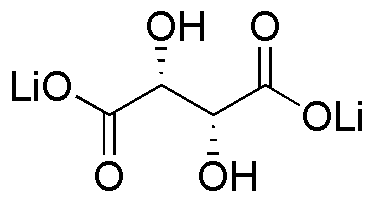Lithium tartrate is widely utilized in research focused on:
- Pharmaceutical Development: It serves as a key ingredient in the formulation of medications for bipolar disorder, helping to stabilize mood and reduce the frequency of manic episodes.
- Analytical Chemistry: Lithium tartrate is used as a standard in various analytical techniques, including NMR spectroscopy, due to its unique chemical properties that aid in the calibration of instruments.
- Biochemistry: In biochemical research, it acts as a buffer component, maintaining pH levels in enzymatic reactions, which is crucial for accurate experimental results.
- Food Industry: It can be utilized as a food additive, enhancing the stability and shelf-life of certain products, particularly in the formulation of dietary supplements.
- Material Science: Lithium tartrate is explored in the development of lithium-ion batteries, contributing to improved energy storage solutions due to its electrochemical properties.
General Information
Properties
Safety and Regulations
Applications
Lithium tartrate is widely utilized in research focused on:
- Pharmaceutical Development: It serves as a key ingredient in the formulation of medications for bipolar disorder, helping to stabilize mood and reduce the frequency of manic episodes.
- Analytical Chemistry: Lithium tartrate is used as a standard in various analytical techniques, including NMR spectroscopy, due to its unique chemical properties that aid in the calibration of instruments.
- Biochemistry: In biochemical research, it acts as a buffer component, maintaining pH levels in enzymatic reactions, which is crucial for accurate experimental results.
- Food Industry: It can be utilized as a food additive, enhancing the stability and shelf-life of certain products, particularly in the formulation of dietary supplements.
- Material Science: Lithium tartrate is explored in the development of lithium-ion batteries, contributing to improved energy storage solutions due to its electrochemical properties.
Documents
Safety Data Sheets (SDS)
The SDS provides comprehensive safety information on handling, storage, and disposal of the product.
Product Specification (PS)
The PS provides a comprehensive breakdown of the product’s properties, including chemical composition, physical state, purity, and storage requirements. It also details acceptable quality ranges and the product's intended applications.
Certificates of Analysis (COA)
Search for Certificates of Analysis (COA) by entering the products Lot Number. Lot and Batch Numbers can be found on a product’s label following the words ‘Lot’ or ‘Batch’.
Número de catálogo
Número de lote/lote
Certificates Of Origin (COO)
This COO confirms the country where the product was manufactured, and also details the materials and components used in it and whether it is derived from natural, synthetic, or other specific sources. This certificate may be required for customs, trade, and regulatory compliance.
Número de catálogo
Número de lote/lote
Safety Data Sheets (SDS)
The SDS provides comprehensive safety information on handling, storage, and disposal of the product.
DownloadProduct Specification (PS)
The PS provides a comprehensive breakdown of the product’s properties, including chemical composition, physical state, purity, and storage requirements. It also details acceptable quality ranges and the product's intended applications.
DownloadCertificates of Analysis (COA)
Search for Certificates of Analysis (COA) by entering the products Lot Number. Lot and Batch Numbers can be found on a product’s label following the words ‘Lot’ or ‘Batch’.
Número de catálogo
Número de lote/lote
Certificates Of Origin (COO)
This COO confirms the country where the product was manufactured, and also details the materials and components used in it and whether it is derived from natural, synthetic, or other specific sources. This certificate may be required for customs, trade, and regulatory compliance.


